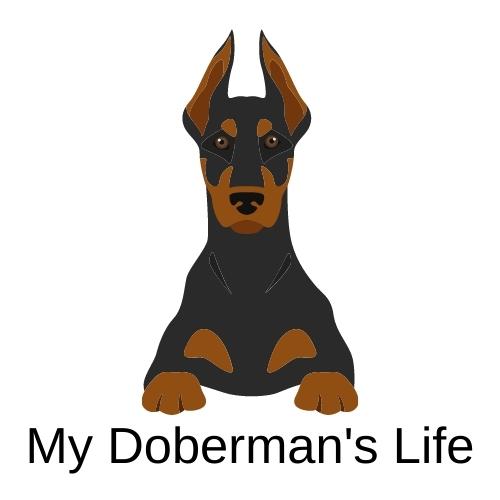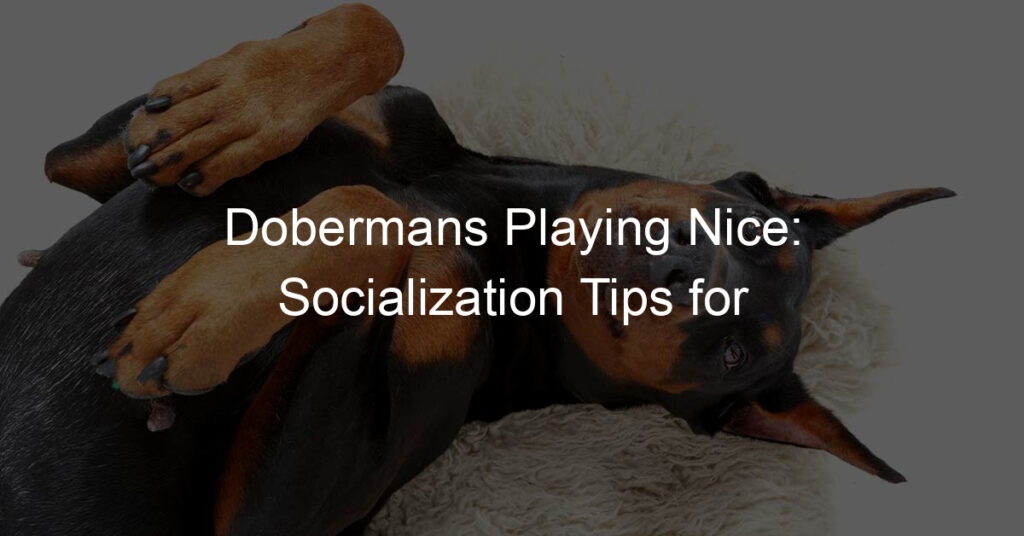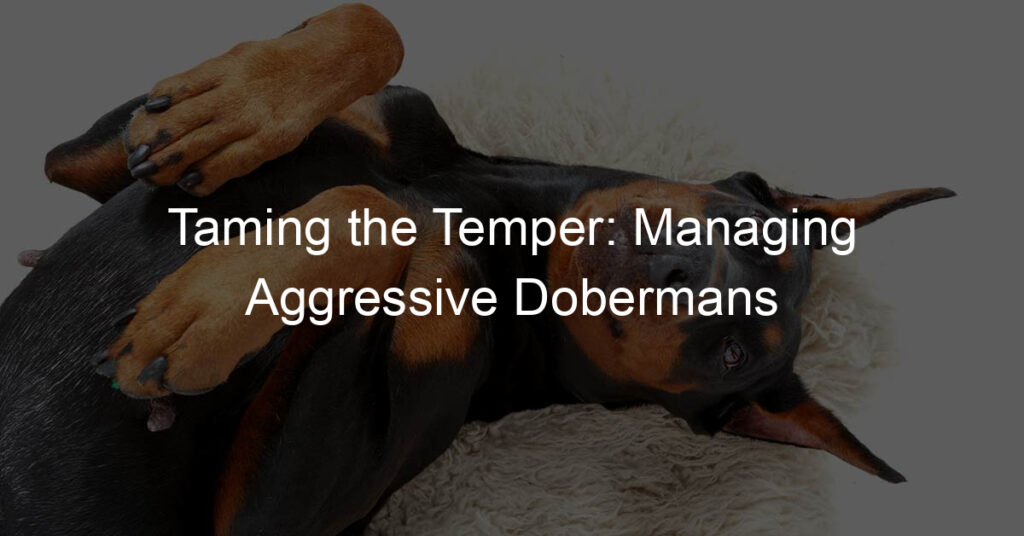
Introduction to Doberman Puppy Training
Training a Doberman puppy is a crucial step in ensuring that your furry friend grows up to be a well-behaved and obedient adult. This process not only helps in establishing a strong bond between you and your pet but also ensures their safety and well-being. In this article, we will delve into the importance of training Doberman puppies and provide an overview of some basic commands that you can start with.
- Understanding the Importance of Training Doberman Puppies
- Overview of Basic Commands for Doberman
Training your Doberman puppy is about more than just teaching them to sit or stay. It’s about instilling good behaviors and habits that will last a lifetime. A well-trained Doberman is not only a joy to be around but also less likely to engage in destructive behaviors. Training also helps to keep your Doberman mentally stimulated and physically active, which contributes to their overall health and happiness.
Training your Doberman puppy should start with basic commands. These include “Sit”, “Stay”, “Come”, “Down”, and “Leave it”. These commands form the foundation of all future training and are essential for your puppy’s safety. For instance, “Stay” can prevent your puppy from running into a busy street, while “Leave it” can stop them from picking up something harmful. Remember, consistency and patience are key when training your Doberman puppy.
In the following sections, we will delve deeper into the preparation for training your Doberman puppy, basic commands for obedience training, behavior training, and some helpful training tips. So, stay tuned to become the best trainer for your Doberman puppy.
Preparation for Training Your Doberman Puppy
Training your Doberman puppy is an exciting journey that requires careful preparation. The first step in this process is setting up the right training environment. This involves choosing the right location and ensuring a distraction-free environment.
Setting Up the Training Environment
Creating a conducive training environment is crucial for your Doberman puppy’s learning process. This environment should be safe, comfortable, and free from distractions. Here’s how you can set up an ideal training environment:
- Choosing the right location for training
- Ensuring a distraction-free environment
The training location should be a familiar place for your puppy. It could be a specific room in your house or a fenced area in your backyard. The key is to choose a location where your puppy feels safe and comfortable. This will help your puppy focus better on the training.
Distractions can hinder your puppy’s learning process. Therefore, it’s important to ensure that the training environment is free from distractions such as loud noises, other pets, or people. You can do this by closing doors and windows, turning off the TV or radio, and asking other family members to stay away from the training area during training sessions.
Remember, the goal is to create an environment that promotes learning and makes training a positive experience for your Doberman puppy. By following these steps, you can set up an ideal training environment and prepare your puppy for successful training sessions.
Tools for Training Doberman Puppies
Training a Doberman puppy requires not just time and patience, but also the right tools. Here are three essential tools you’ll need:
- Training Leash
A training leash is a must-have tool for every dog owner. It helps you control your puppy during training sessions and ensures their safety. The leash should be comfortable for your puppy and easy for you to hold. Remember, the leash is not a punishment tool, but a means to guide your puppy.
- Treats for Rewards
Positive reinforcement is a powerful training method. When your Doberman puppy follows a command correctly, reward them with a treat. This encourages them to repeat the behavior. Choose healthy treats that your puppy loves, but remember to give them in moderation.
- Clicker for Clicker Training
Clicker training is a popular method used to train dogs. The clicker is a small device that makes a distinct sound. When your puppy performs the desired behavior, you click the device and give them a treat. This helps your puppy associate the sound with the positive action, making training more effective.
These tools are just the beginning. Remember, the most important tool in training your Doberman puppy is your patience and consistency. Happy training!
Basic Commands for Doberman Puppy Obedience Training
Training your Doberman puppy can be a rewarding experience for both you and your new furry friend. One of the first commands you’ll want to teach your Doberman puppy is the “Sit” command. This command is fundamental in obedience training and can help your puppy learn discipline and respect.
Doberman Sit Command
The sit command is a basic command that every dog should know. It’s a simple command that can be taught in a few easy steps. But remember, patience and consistency are key when training your Doberman puppy.
-
Steps to teaching the sit command
Start by holding a treat close to your puppy’s nose. Move your hand up, allowing their head to follow the treat and causing their bottom to lower. Once they’re in sitting position, say “Sit”, give them the treat and share affection.
Repeat this sequence a few times every day until your puppy has it mastered. Then ask your puppy to sit before mealtime, when leaving for walks, and during other situations where you’d like them calm and seated.
-
Common mistakes and how to avoid them
One common mistake is giving the command too many times. If your puppy doesn’t sit on the first command, don’t repeat it. Instead, show them what you want them to do. Another mistake is not rewarding your puppy immediately after they sit. The reward must come right after the action so your puppy can make the connection between the action and the reward.
Avoid these mistakes by being patient, consistent and always rewarding your puppy immediately after they follow the command.
Remember, training should be a fun and rewarding experience for your Doberman puppy. Keep sessions short and positive, and always end on a high note. With patience and consistency, your Doberman puppy will be sitting on command in no time.
Doberman Stay Command
Training your Doberman puppy to obey the “stay” command is a vital part of their obedience training. This command not only ensures your puppy’s safety but also helps in maintaining discipline. Let’s discuss how to teach this command effectively and practice it with distractions.
-
Teaching the Stay Command Effectively
Start by making sure your Doberman puppy is comfortable and in a calm state. Use a clear, firm voice to say “stay”, while extending your hand in a stop gesture. Make sure to maintain eye contact. If your puppy stays, reward them with a treat or praise. Repeat this process until your puppy understands the command.
Step Action 1 Ensure the puppy is calm and comfortable 2 Use a clear, firm voice to say “stay” 3 Extend your hand in a stop gesture 4 Maintain eye contact 5 Reward the puppy if they obey 6 Repeat the process -
Practicing the Stay Command with Distractions
Once your puppy has mastered the stay command in a quiet environment, it’s time to introduce distractions. You can start with simple distractions like a toy or another person. Gradually increase the level of distraction, always rewarding your puppy for successfully staying. Remember, patience is key when training your Doberman puppy.
For example, you can ask a family member to walk past while you command your puppy to stay. If your puppy remains in place, reward them with a treat. This practice will help your puppy understand that they must obey the command, regardless of distractions.
In conclusion, teaching your Doberman puppy the stay command requires patience and consistency. But with time and practice, your puppy will learn to obey this command, ensuring their safety and good behavior.
Doberman Puppy Behavior Training
Training your Doberman puppy to behave appropriately is an essential part of their development. It’s not just about teaching them to sit or stay, but also about addressing common behavioral issues that can arise. Let’s dive into some of these issues and how to manage them effectively.
Addressing Common Behavioral Issues
Here are some common behavioral issues Doberman puppies may exhibit and how you can address them:
- Dealing with biting and nipping
- Preventing excessive barking
- Managing separation anxiety
Biting and nipping are normal behaviors for puppies as they explore their world. However, it’s important to teach your Doberman puppy that this behavior is not acceptable. One effective method is to respond with a firm “No!” each time your puppy bites or nips. Then, redirect their attention to a toy or chewable item. This teaches them what is acceptable to bite or chew on.
While some barking is normal, excessive barking can be a nuisance. To prevent this, try to understand why your puppy is barking. Are they bored? Scared? Lonely? Once you understand the cause, you can address it directly. For example, if your puppy is barking out of boredom, providing them with toys or activities can help.
Separation anxiety is common in Doberman puppies. They are a breed that forms strong bonds with their owners and can become anxious when left alone. To manage this, try gradually increasing the amount of time you spend away from your puppy. Start with short periods and slowly increase the duration. Also, providing them with a safe, comfortable space of their own can help them feel more secure.
Remember, patience and consistency are key when it comes to behavior training. It may take time, but with the right approach, you can help your Doberman puppy grow into a well-behaved adult dog.
Positive Reinforcement in Behavior Training
When it comes to training your Doberman puppy, one of the most effective methods is positive reinforcement. This approach is not only beneficial for teaching new commands, but also for shaping your puppy’s behavior in a positive way.
- Importance of Positive Reinforcement
- Examples of Positive Reinforcement in Action
Positive reinforcement is a powerful tool in behavior training. It works by rewarding your puppy’s good behavior, which encourages them to repeat it. This method is based on the principle that behaviors followed by pleasant consequences are likely to be repeated. It’s a kind, effective, and scientifically proven method to train your Doberman puppy.
Studies show that dogs trained using positive reinforcement are more likely to obey commands and exhibit less problematic behaviors. This method also helps to build a strong bond between you and your puppy, making training sessions enjoyable for both of you.
Positive reinforcement can take many forms, from verbal praise to treats. Here are a few examples:
| Behavior | Positive Reinforcement |
|---|---|
| Your puppy sits when asked | You give a treat and praise |
| Your puppy comes when called | You pet and praise them |
| Your puppy stays calm when visitors arrive | You give a favorite toy |
Remember, the key to successful positive reinforcement is timing. The reward must be given immediately after the desired behavior, so your puppy associates the reward with the behavior. With consistency and patience, your Doberman puppy will learn to associate good behavior with positive outcomes, leading to a well-behaved and happy pet.
Doberman Puppy Training Tips
Training a Doberman puppy can be a rewarding experience, but it requires patience, consistency, and understanding. Here are some essential tips to help you train your Doberman puppy effectively.
- Maintaining Consistency in Training
Consistency is key when training your Doberman puppy. This means sticking to the same commands, rewards, and consequences each time. If you change your approach frequently, your puppy may become confused and less likely to respond to your commands. For example, if you use the command “sit” one day and “down” the next to instruct your puppy to sit, it may not understand what you want it to do. Consistency helps your puppy understand what is expected and reinforces good behavior.
- Understanding Your Doberman’s Body Language
Understanding your Doberman’s body language is crucial to effective training. Dogs communicate primarily through body language, and by paying attention to your Doberman’s signals, you can better understand its needs and responses. For instance, a wagging tail can indicate happiness, while flattened ears may signal fear or aggression. By understanding these signals, you can adjust your training approach to suit your puppy’s mood and ensure a positive training experience.
- Importance of Socialization in Doberman Puppy Training
Socialization is an essential part of Doberman puppy training. This involves exposing your puppy to a variety of people, places, and situations to help it become comfortable in different environments. Socialization can help reduce fear and aggression in your Doberman, making it more friendly and approachable. It can also make training easier, as your puppy will be less likely to be distracted or scared in new situations. Start socializing your puppy at a young age and continue this practice throughout its life for the best results.
Remember, training your Doberman puppy requires patience and consistency, but the rewards are well worth the effort. By following these tips, you can help your puppy grow into a well-behaved and happy adult dog.
Conclusion: Your Doberman Puppy Training Guide
As we wrap up this comprehensive guide on Doberman puppy training, let’s take a moment to revisit the key takeaways and explore some resources for continued learning and training.
- Recap of key takeaways
- Preparing for training: We learned that setting up a routine and creating a positive environment are crucial steps before starting the training process.
- Basic commands: We discovered the importance of teaching your Doberman puppy basic commands like ‘sit’, ‘stay’, and ‘come’ for obedience and safety.
- Behavior training: We discussed how to address common behavioral issues, such as biting and barking, using positive reinforcement techniques.
- Training tips: We shared valuable tips, like keeping training sessions short and fun, using treats as rewards, and being consistent with commands.
- Continued learning and training resources
- Books: There are numerous books available that delve deeper into Doberman training techniques. Some popular titles include ‘Doberman Training Guide’ and ‘The Doberman Puppy Handbook’.
- Videos: Online platforms like YouTube have a wealth of video tutorials on Doberman training. These visual guides can be particularly helpful in demonstrating techniques.
- Classes: Consider enrolling your puppy in obedience classes. These classes can provide socialization opportunities and hands-on training guidance.
Training your Doberman puppy is a rewarding journey that requires patience, consistency, and understanding. We’ve covered a lot of ground, including:
Training your Doberman puppy doesn’t stop here. It’s a continuous process that evolves as your puppy grows. Here are some resources to help you along the way:
Remember, every Doberman puppy is unique and what works for one might not work for another. Stay patient, keep learning, and enjoy the rewarding journey of raising a well-trained Doberman puppy.








